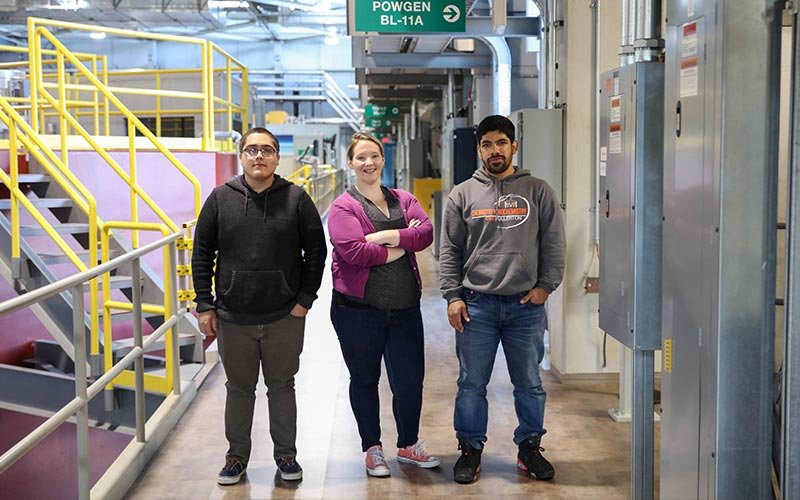
Two chemistry students had the chance to perform experiments at Oak Ridge National Laboratory, a science and energy lab in rural Tennessee originally built for the Manhattan Project in an effort to develop the atomic bomb during World War II.
Undergraduates Jose Gonzalez Jimenez and Daniel Sandoval, under the guidance of their research adviser Allyson Fry-Petit, assistant professor of chemistry and biochemistry, recently conducted cutting-edge science experiments at the U.S. Department of Energy lab. The researchers’ work is helping to advance Fry-Petit’s faculty-student research project on how oxygen moves through solid materials, known as oxygen transport membranes.
This research with her students, including their work at the national lab, is supported by a grant from the American Chemical Society Petroleum Research Fund.
“This experiment allowed us to study the separation of oxygen from air for a variety of applications, including for use in medical applications, steel and petroleum refining and alternative fuel cells,” said Fry-Petit, who first visited the lab as a graduate student. Petroleum refining not only requires a great deal of oxygen, it’s a difficult and expensive process, she noted.
“The petroleum industry is interested in this technology since it could drive down the costs of current energy generation, while creating greener energy alternatives,” added Fry-Petit, who serves on the national lab’s executive committee that represents scientists who use the large-scale neutron facilities.
Working alongside the lab’s scientists and using high-tech instruments was a rare opportunity — since few undergraduates are invited to work at the lab and use the special instrument called POWGEN, a neutron powder diffractometer, Fry-Petit said. This instrument scans and collects neutron diffraction data, which when coupled with the instrument configuration used, performed a one-of-kind experiment, she added.
“Using neutrons — fundamental particles that make up all atoms — to probe the arrangement of atoms in solids has revolutionized how chemists design new materials that impact our daily lives,” Fry-Petit pointed out.
To perform the experiments, chemical samples prepared in Fry-Petit’s campus lab were placed in tiny glass tubes that allowed the amount of oxygen in the air around the sample to be controlled, then the tubes were placed inside the neutron diffractometer. Data collection proceeded 24 hours a day over four days. This experiment allowed the researchers to observe oxygen in the presence of heavy metals, Jimenez explained.
Back in her CSUF lab, Fry-Petit and her students are now analyzing the large amount of data they collected at the national lab. She also plans to return to the eastern Tennessee lab, located near Knoxville, with more students to continue work on the ongoing research project.
Jimenez, who aspires to become an inorganic chemist, a branch of chemistry that often includes studying metals, relayed that working in the lab was an eye-opening experience: “Getting to go to the national lab was a great-stepping stone and was incredibly rewarding.”
For Sandoval, who plans a research career in industry, the experience helped him sharpen his lab skills, including how to perform quantitative analysis of data focused on a material’s chemical components, as well as what specific questions to ask when conducting such high-level experiments.
“I was surprised at the number of scientists it takes to maintain and operate just one instrument,” Sandoval added. He also is working on a separate research project in Fry-Petit’s lab to develop safer, non-flammable solid-state batteries to create electricity for vehicles or batteries for laptops.
While at the lab, the students, both the first in their families to attend college and who are considering pursuing doctorates, toured a nuclear reactor and talked to scientists about their journeys in science, as well as potential careers.
“I see a lot of promise in Jose and Daniel in their ability to do high-level research,” Fry-Petit said. “An experience like this broadens their horizon on the breadth of topics they can study and they’re able to envision a career at a scientific facility. I’m excited to see the impact it has on their scientific careers.”